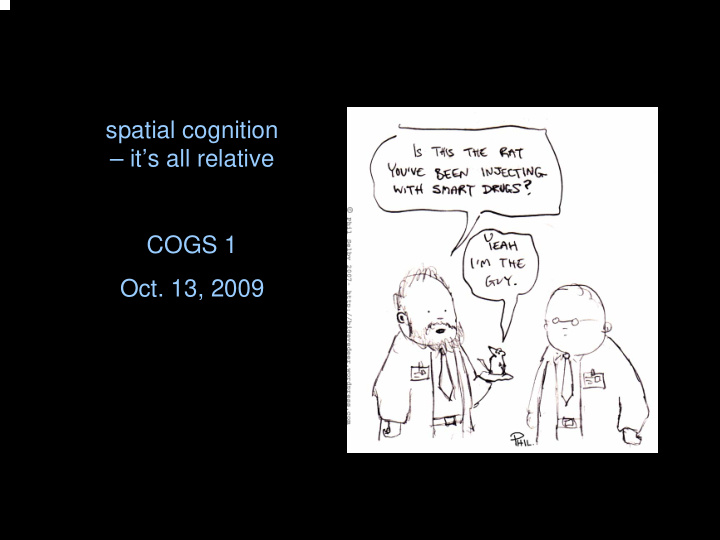



spatial cognition – it’s all relative COGS 1 Oct. 13, 2009
Einstein and Picasso knew a thing or two about relativity…
similarity in features of navigational strategies across mammalian species similarity in detailed structure of brain across mammalian species human brain – sagittal view rat brain – dorsal view
15 10 Hz 0 0 8 Hz 0 ‘place’ field recording occupancy counts firing rate firing rate hippocampal pyramidal neuron 1 neuron 2 neuron Wilent and Nitz, 2007 tetrode (braided set of 4 electrodes) 28-tetrode microdrive relative-amplitude spike discrimination
MAPPING SPACE IN THE BRAIN – RULE 1: THERE ARE MANY POSSIBLE WAYS depth perception from motion parallax or depth perception from texture gradient or depth perception from occlusion or depth perception from retinal disparity (stereopsis) : : but which?
MAPPING SPACE IN THE BRAIN – RULE 2: DEFINE THE FRAME OF REFERENCE egocentric frames arbitrary frames allocentric (world-centered) retinal space senses vestibular info. route-centered musculature proprioception object-centered * *
The Morris Water Tank Navigational Task …like humans, animals know where they are in ‘allocentric’ space and this is dependent on the hippocampus
‘head-direction cells’ – neurons fire action potentials at rates that depend on the orientation of the animal’s head relative to the environment …firing rate for the preferred direction is even higher if the animal is moving faster
THE ENTORHINAL CORTEX – ALLOCENTRIC (i.e., WORLD-CENTERED) SPATIAL MAPPING VIA ‘GRID CELLS” grid node ‘ratemap’ of an individual entorhinal cortex neuron grid nodes follow a pattern of tesselated triangles
DYNAMICS FROM STRUCTURE – HOW DOES ENTORHINAL CORTEX SUB-STRUCTURE PRODUCE GRID-CELL DYNAMICS? McNaughton et al., 2006, Nature Reviews Neuroscience
how do grid cells yield hippocampal allocentric position maps? McNaughton et al., 2006, Nature Reviews Neuroscience
THE HIPPOCAMPUS – ALLOCENTRIC (i.e., WORLD-CENTERED) SPATIAL MAPPING VIA ‘PLACE CELLS’ 0 10 Hz place color-mapping field of action potential frequency X space ‘ratemap’ of an individual hippocampal neuron
tracking position in the world-centered (allocentric) frame of reference: the ‘place cell’ – firing is tuned to the position of the animal in the environment (the place ‘field’) – different neurons map different positions (all directions are represented) – rotation of the environment boundaries = rotation of the place fields
the effects of damage to the parietal cortex in humans gives clues as to how ‘object-centered’ space is represented in the brain
the ‘what’ and ‘where’ pathways of the mammalian brain where what arising from primary visual processing in the occipital lobe, visual information travels: 1) to the temporal lobe where neurons fire action potentials in response to particular objects no matter where they are 2) to the parietal lobe where neurons fire action potentials in response to where an object is irrespective of what it is
area VIP of parietal cortex I: bringing together personal (egocentric) spaces of the somatosensory and visual systems
area VIP of parietal cortex II: bringing together personal (egocentric) spaces of the somatosensory and visual systems …and movement related to them Duhamel et al., JNP, 1998
Nitz, Neuron, 2006 parietal cortex neurons in behaving rats map path segments (e.g., start pt. to first R turn) familiar path newly-learned path inbound inbound inbound outbound 10 Hz outbound 0
parietal cortex: a rather abstract frame of reference – the space defined by the route (i.e., the space defined by sequence of behavior changes and the spaces separating them) goal start 35 R path 10 - outbound outbound start L 0 r beh = 0.86 35 r space = 0.23 R inbound firing rate L 0 goal L 35 goal path 10 - inbound r beh = 0.89 R 0 r space = 0.16 L 35 start R 0 L R L R Nitz, Neuron, 2006
BOLD SIGNALS IMPLICATE HIPPOCAMPUS AND PARIETAL CORTEX IN NOVEL SCENE CONSTRUCTION Hassabis et al., JNS, 2007
Recommend
More recommend